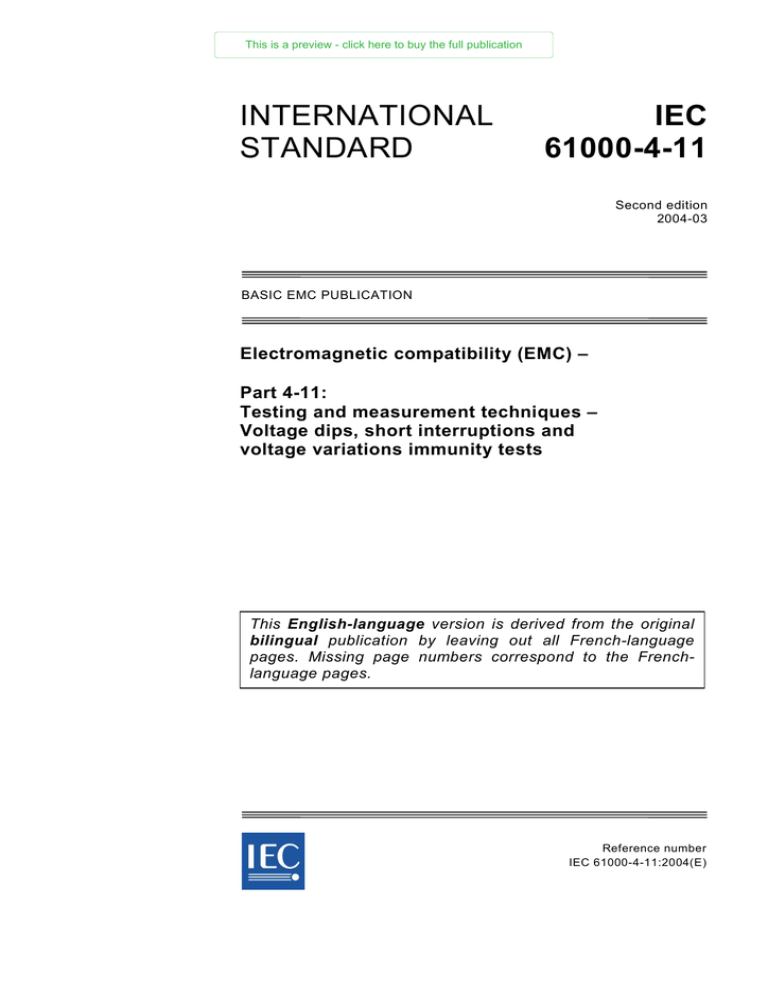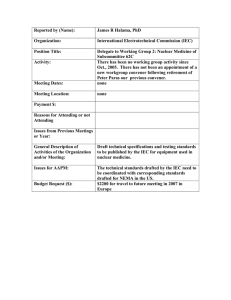
This is a preview - click here to buy the full publication
INTERNATIONAL
STANDARD
IEC
61000-4-11
Second edition
2004-03
BASIC EMC PUBLICATION
Electromagnetic compatibility (EMC) –
Part 4-11:
Testing and measurement techniques –
Voltage dips, short interruptions and
voltage variations immunity tests
This English-language version is derived from the original
bilingual publication by leaving out all French-language
pages. Missing page numbers correspond to the Frenchlanguage pages.
Reference number
IEC 61000-4-11:2004(E)
This is a preview - click here to buy the full publication
INTERNATIONAL
STANDARD
IEC
61000-4-11
Second edition
2004-03
BASIC EMC PUBLICATION
Electromagnetic compatibility (EMC) –
Part 4-11:
Testing and measurement techniques –
Voltage dips, short interruptions and
voltage variations immunity tests
IEC 2004 Copyright - all rights reserved
No part of this publication may be reproduced or utilized in any form or by any means, electronic or mechanical,
including photocopying and microfilm, without permission in writing from the publisher.
International Electrotechnical Commission, 3, rue de Varembé, PO Box 131, CH-1211 Geneva 20, Switzerland
Telephone: +41 22 919 02 11 Telefax: +41 22 919 03 00 E-mail: inmail@iec.ch Web: www.iec.ch
Com mission Electrotechnique Internationale
International Electrotechnical Com m ission
Международная Электротехническая Комиссия
PRICE CODE
For price, see current catalogue
U
This is a preview - click here to buy the full publication
61000-4-11 IEC:2004
–3–
CONTENTS
FOREWORD...........................................................................................................................5
INTRODUCTION .....................................................................................................................9
1
Scope ............................................................................................................................. 11
2
Normative references...................................................................................................... 11
3
Terms and definitions ..................................................................................................... 11
4
General .......................................................................................................................... 15
5
Test levels ...................................................................................................................... 15
6
Test instrumentation ....................................................................................................... 23
7
Test set-up ..................................................................................................................... 27
8
Test procedures.............................................................................................................. 29
9
Evaluation of test results ................................................................................................. 33
10 Test report...................................................................................................................... 35
Annex A (normative) Test circuit details................................................................................ 37
Annex B (informative) Electromagnetic environment classes................................................. 43
Annex C (informative) Test instrumentation .......................................................................... 45
Bibliography .......................................................................................................................... 51
Figure 1 – Voltage dip - Examples ......................................................................................... 21
Figure 2 – Short interruption .................................................................................................. 21
Figure 3 – Voltage variation................................................................................................... 23
Figure 4 – Phase-to-neutral and phase-to-phase testing on three-phase systems................... 33
Figure A.1 – Circuit for determining the inrush current drive capability of the short
interruptions generator .......................................................................................................... 39
Figure A.2 – Circuit for determining the peak inrush current requirement of an EUT ............... 41
Figure C.1 – Schematics of test instrumentation for voltage dips, short interruptions
and voltage variations ........................................................................................................... 47
Figure C.2 – Schematic of test instrumentation for three-phase voltage dips, short
interruptions and voltage variations using power amplifier ...................................................... 49
Table 1 – Preferred test level and durations for voltage dips .................................................. 17
Table 2 – Preferred test level and durations for short interruptions ......................................... 17
Table 3 – Timing of short-term supply voltage variations ........................................................ 19
Table 4 – Generator specifications ........................................................................................ 25
This is a preview - click here to buy the full publication
61000-4-11 IEC:2004
–5–
INTERNATIONAL ELECTROTECHNICAL COMMISSION
____________
ELECTROMAGNETIC COMPATIBILITY (EMC) –
Part 4-11: Testing and measurement techniques –
Voltage dips, short interruptions and
voltage variations immunity tests
FOREWORD
1) The International Electrotechnical Commission (IEC) is a worldwide organization for standardization comprising
all national electrotechnical committees (IEC National Committees). The object of IEC is to promote
international co-operation on all questions concerning standardization in the electrical and electronic fields. To
this end and in addition to other activities, IEC publishes International Standards, Technical Specifications,
Technical Reports, Publicly Available Specifications (PAS) and Guides (hereafter referred to as “IEC
Publication(s)”). Their preparation is entrusted to technical committees; any IEC National Committee interested
in the subject dealt with may participate in this preparatory work. International, governmental and nongovernmental organizations liaising with the IEC also participate in this preparation. IEC collaborates closely
with the International Organization for Standardization (ISO) in accordance with conditions determined by
agreement between the two organizations.
2) The formal decisions or agreements of IEC on technical matters express, as nearly as possible, an international
consensus of opinion on the relevant subjects since each technical committee has representation from all
interested IEC National Committees.
3) IEC Publications have the form of recommendations for international use and are accepted by IEC National
Committees in that sense. While all reasonable efforts are made to ensure that the technical content of IEC
Publications is accurate, IEC cannot be held responsible for the way in which they are used or for any
misinterpretation by any end user.
4) In order to promote international uniformity, IEC National Committees undertake to apply IEC Publications
transparently to the maximum extent possible in their national and regional publications. Any divergence
between any IEC Publication and the corresponding national or regional publication shall be clearly indicated in
the latter.
5) IEC provides no marking procedure to indicate its approval and cannot be rendered responsible for any
equipment declared to be in conformity with an IEC Publication.
6) All users should ensure that they have the latest edition of this publication.
7) No liability shall attach to IEC or its directors, employees, servants or agents including individual experts and
members of its technical committees and IEC National Committees for any personal injury, property damage or
other damage of any nature whatsoever, whether direct or indirect, or for costs (including legal fees) and
expenses arising out of the publication, use of, or reliance upon, this IEC Publication or any other IEC
Publications.
8) Attention is drawn to the Normative references cited in this publication. Use of the referenced publications is
indispensable for the correct application of this publication.
9) Attention is drawn to the possibility that some of the elements of this IEC Publication may be the subject of
patent rights. IEC shall not be held responsible for identifying any or all such patent rights.
International Standard IEC 61000-4-11 has been prepared by subcommittee 77A: Low
frequency phenomena, of IEC technical committee 77: Electromagnetic compatibility.
This second edition cancels and replaces the first edition published in 1994 and its amendment
1 (2000). This second edition constitutes a technical revision in which
1) preferred test values and durations have been added for the different environment classes;
2) the tests for the three-phase systems have been specified.
It forms part 4-11 of IEC 61000. It has the status of a Basic EMC Publication in accordance
with IEC Guide 107.
This is a preview - click here to buy the full publication
61000-4-11 IEC:2004
–7–
The text of this standard is based on the following documents:
FDIS
Report on voting
77A/452/FDIS
77A/455/RVD
Full information on the voting for the approval of this standard can be found in the report on
voting indicated in the above table.
This publication has been drafted in accordance with the ISO/IEC Directives, Part 2.
The committee has decided that the contents of this publication will remain unchanged until
2008. At this date, the publication will be
•
reconfirmed;
•
withdrawn;
•
replaced by a revised edition, or
•
amended.
This is a preview - click here to buy the full publication
61000-4-11 IEC:2004
–9–
INTRODUCTION
IEC 61000 is published in separate parts according to the following structure:
Part 1: General
General considerations (introduction, fundamental principles)
Definitions, terminology
Part 2: Environment
Description of the environment
Classification of the environment
Compatibility levels
Part 3: Limits
Emission limits
Immunity limits (in so far as they do not fall under the responsibility of the product
committees)
Part 4: Testing and measurement techniques
Measurement techniques
Testing techniques
Part 5: Installation and mitigation guidelines
Installation guidelines
Mitigation methods and devices
Part 6: Generic standards
Part 9: Miscellaneous
Each part is further subdivided into several parts, published either as International Standards
or as technical specifications or technical reports, some of which have already been published
as sections. Others will be published with the part number followed by a dash and a second
number identifying the subdivision (example: 61000-6-1).
This is a preview - click here to buy the full publication
61000-4-11 IEC:2004
– 11 –
ELECTROMAGNETIC COMPATIBILITY (EMC) –
Part 4-11: Testing and measurement techniques –
Voltage dips, short interruptions and
voltage variations immunity tests
1
Scope
This part of IEC 61000 defines the immunity test methods and range of preferred test levels
for electrical and electronic equipment connected to low-voltage power supply networks for
voltage dips, short interruptions, and voltage variations.
This standard applies to electrical and electronic equipment having a rated input current not
exceeding 16 A per phase, for connection to 50 Hz or 60 Hz a.c. networks.
It does not apply to electrical and electronic equipment for connection to 400 Hz a.c. networks.
Tests for these networks will be covered by future IEC standards.
The object of this standard is to establish a common reference for evaluating the immunity of
electrical and electronic equipment when subjected to voltage dips, short interruptions and
voltage variations.
NOTE
Voltage fluctuation immunity tests are covered by IEC 61000-4-14.
The test method documented in this part of IEC 61000 describes a consistent method to
assess the immunity of equipment or a system against a defined phenomenon. As described in
IEC Guide 107, this is a basic EMC publication for use by product committees of the IEC. As
also stated in Guide 107, the IEC product committees are responsible for determining whether
this immunity test standard should be applied or not, and, if applied, they are responsible for
defining the appropriate test levels. Technical committee 77 and its sub-committees are
prepared to co-operate with product committees in the evaluation of the value of particular
immunity tests for their products.
2
Normative references
The following referenced documents are indispensable for the application of this document. For
dated references, only the edition cited applies. For undated references, the latest edition of
the referenced document (including any amendments) applies.
IEC 61000-2-8, Electromagnetic compatibility (EMC) − Part 2-8: Environment − Voltage dips
and short interruptions on public electric power supply systems with statistical measurement
results
3
Terms and definitions
For the purpose of this document, the following terms and definitions apply:




